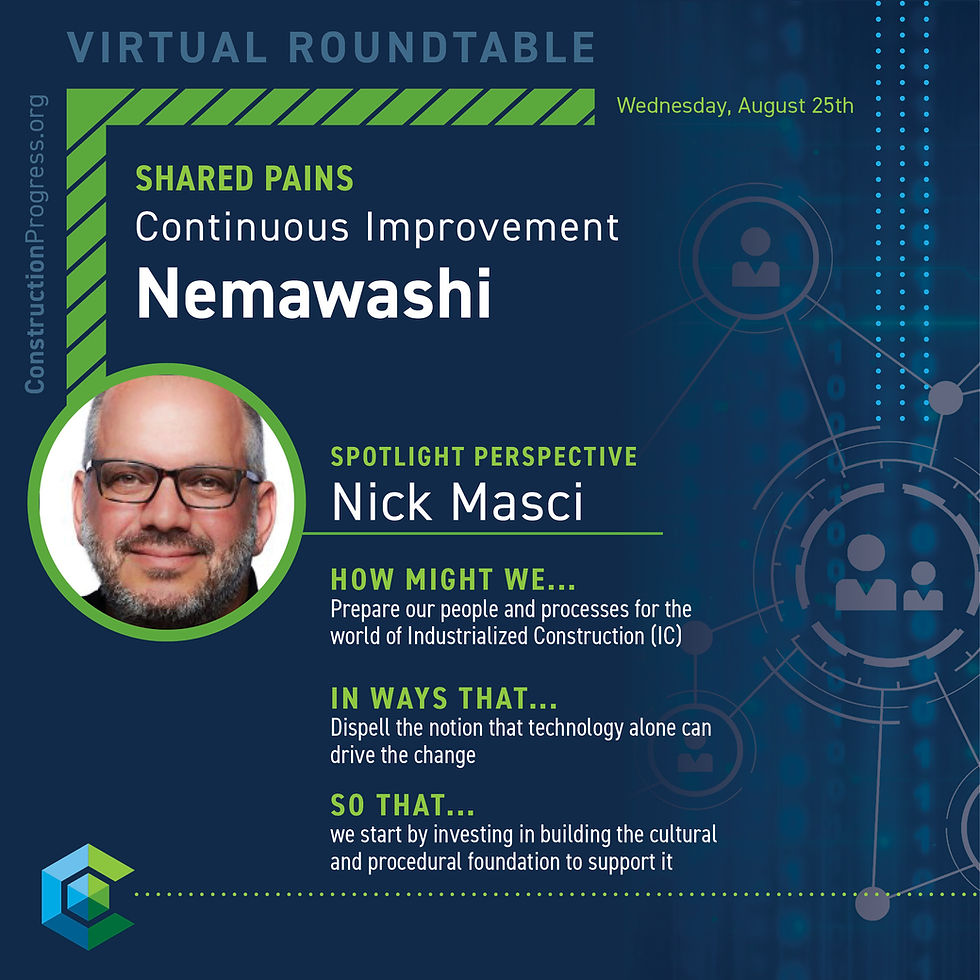April 12th Roundtable Recap
- Construction Progress Coalition

- Jun 21, 2023
- 4 min read

In our last roundtable, Anil Sawhney, Laurie Spitler, and DJ Phipps joined me and our participants to discuss different #sharedperspectives.
Read the transcriptions from April 12th below to learn more about equipment procurement, the WIP lifecycle, and issue analytics.
Equipment Procurement

"I think we had a fantastic discussion, on the term Digital Twin. I think it's really all about data. And if it's all about data, we probably do not need new data standards, we just need a governance model, which can help us interconnect these schemas, and make them more relevant to downstream players in the supply chain. So right now, I think it's done much upstream or in silos without listening to the business requirements of contractors, subcontractors, trade partners, and so on.
I think what I learned from all the discussion was that ultimately, it's about us as a group, promoting discussion across other groups, connecting them together, like building smart International is one good example. So we need an industry wide push to make it happen. So I hope all that made sense. I personally enjoyed the opportunity to attend that session. I hope others did. Also, we had wonderful presentations. I'm sure you will all be able to see in the recording and great exchange of ideas."
The WIP Lifecycle

"My tagline is essentially WIP reporting is an art, not a science. And the things that struck me in that chord were number one, that the relationship between the surety broker and the shorties and the construction and contractors is really it's a relationship driven business.
That I think was you were talking about how 5% of WIP reporting comes with a phone call. And it's really about providing context. And the interesting contrast we got there and different points in the call, we had the contractor perspective, that perhaps there's some fear that if we moved to this standardized or automated way of reporting, you lose that relationship. But then from the surety perspective, was like, oh, no, no, no, actually, if we go to standardization, it improves the relationship and you were more reliable.
So it seemed like there was maybe in that perspective, a little counseling session that could happen, where, you know, surely providers and brokers could really help contractors understand how the relationship will continue and that it is important. But then if we dig a little bit deeper, you know, we talked about what goes into a web report and essentially, you know, the different sources and the different areas for and different sources of knowledge within a contractor for the forecasting, versus the job to date reporting, and how aligning those is also an art because the forecasting is really an experience stripping game and having flexibility to adjust those numbers or incorporate that context prior to the WIP reporting was incredibly important.
So it's not just about aligning or standardizing on one system or getting one system to be able to produce this. It's really about business practices within a contractor.
The human element, all the way through really was a learning element for me. And it seems like addressing that human element actually is essential to standardization. And the objection may not be so much to standardization itself. But we really need to unlock that, before potentially, we can get to some of the benefits, wider benefits of consistent reporting and standardization for contractors."
Issue Analytics

"Lots of interesting perspectives from from like Kelly and Rachel, from the design side. We pretty much came into an agreement, where we talked about locations and about the need to no longer have locations be linear in nature, but more of like a multi relational type of things like basically creating a Rosetta Stone when it came to locations. And kind of further defining what but the word location means to different users, and different people that are involved with the project, whether it's drawings, floors, levels, areas, poor sequences, work breakdown, structure, work, packaging, survey coordinates, project internal coordinates, site layout, northing and easting as GIS like all this stuff is there and trying to help kind of bring it together.
At the end of the day, when issues do come up there's there's Some beans to kind of help create the sort of like a measure of impact so that those like when there is a design change or an RFI or something comes through, instead of just having to sift through 30 RFI as it come through a day, you're actually able to see, hey, the significance of impact on your particular system or your scope of work that you currently have. You may need to actually really look at this RFI, instead of just kind of glancing over it because that kind of gets a waterfall effect of one RFI, it leads to another RFI, which leads to another RFI, when it could have potentially been solved earlier, we did not figure out like who's going to create it, and who's going to babysit it and who's going to pay for it.
We need to push back more a little bit about, you know, creating the standards and forcing adherence to the standards and just instead of letting people kind of continue to do things the way they were right, because we are all tired of the phrase that gets used a lot in construction."








Comments